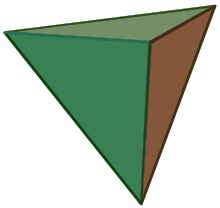Definify.com
Definition 2025
Platonic_solid
Platonic solid
English

A tetrahedron, one of the Platonic solids
Alternative forms
- platonic solid (US)
Noun
Platonic solid (plural Platonic solids)
- (geometry) Any of five convex polyhedra with congruent regular polygonal faces, which have a high degree of symmetry and have been studied since antiquity.
- 1961, J. S. Griffith, The Theory of Transition-Metal Ions, page 41,
- As the names suggest, the groups and their existence are connected to the five Platonic solids. They are in fact the rotation groups of the Platonic solids.
- 1993, Aharon Kantorovich, Scientific Discovery: Logic and Tinkering, page 160,
- The erroneous number of planets, six, gave him[Johannes Kepler] the clue for his model of five Platonic solids (the five regular convex polyhedra) on which he erected the universe.
- 2015, Alexander A. Stepanov, Daniel E. Rose, From Mathematics to Generic Programming, page 44,
- In the 13th and final book, he[Euclid] shows how to construct the five Platonic solids, and proves that they are the only regular polyhedra (bodies whose faces are congruent, regular polygons) that exist.
- 1961, J. S. Griffith, The Theory of Transition-Metal Ions, page 41,
Hyponyms
- (Any of five polyhedra): cube, dodecahedron, icosahedron, octahedron, regular hexahedron (cube), tetrahedron
Translations
Any one of five polyhedra
|
|
Related terms
See also
- Archimedean solid
- Catalan solid
- Johnson solid
- Kepler solid
-
 Platonic solid on Wikipedia.Wikipedia
Platonic solid on Wikipedia.Wikipedia
-
 Regular 4-polytope on Wikipedia.Wikipedia
Regular 4-polytope on Wikipedia.Wikipedia
-
 List of regular polytopes and compounds on Wikipedia.Wikipedia
List of regular polytopes and compounds on Wikipedia.Wikipedia
platonic_solid
Platonic solid
English

A tetrahedron, one of the Platonic solids
Alternative forms
- platonic solid (US)
Noun
Platonic solid (plural Platonic solids)
- (geometry) Any of five convex polyhedra with congruent regular polygonal faces, which have a high degree of symmetry and have been studied since antiquity.
- 1961, J. S. Griffith, The Theory of Transition-Metal Ions, page 41,
- As the names suggest, the groups and their existence are connected to the five Platonic solids. They are in fact the rotation groups of the Platonic solids.
- 1993, Aharon Kantorovich, Scientific Discovery: Logic and Tinkering, page 160,
- The erroneous number of planets, six, gave him[Johannes Kepler] the clue for his model of five Platonic solids (the five regular convex polyhedra) on which he erected the universe.
- 2015, Alexander A. Stepanov, Daniel E. Rose, From Mathematics to Generic Programming, page 44,
- In the 13th and final book, he[Euclid] shows how to construct the five Platonic solids, and proves that they are the only regular polyhedra (bodies whose faces are congruent, regular polygons) that exist.
- 1961, J. S. Griffith, The Theory of Transition-Metal Ions, page 41,
Hyponyms
- (Any of five polyhedra): cube, dodecahedron, icosahedron, octahedron, regular hexahedron (cube), tetrahedron
Translations
Any one of five polyhedra
|
|
Related terms
See also
- Archimedean solid
- Catalan solid
- Johnson solid
- Kepler solid
-
 Platonic solid on Wikipedia.Wikipedia
Platonic solid on Wikipedia.Wikipedia
-
 Regular 4-polytope on Wikipedia.Wikipedia
Regular 4-polytope on Wikipedia.Wikipedia
-
 List of regular polytopes and compounds on Wikipedia.Wikipedia
List of regular polytopes and compounds on Wikipedia.Wikipedia